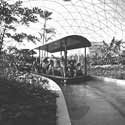IPM Works Magic at Walt Disney World: Florida Sustainable Agriculture Survey Yields IPM Results
by Dr. Marilyn Swisher, Associate Professor of Home Economics
 When one thinks of Walt Disney World, images of Mickey Mouse and
Donald Duck come to mind. But, beyond the magic of this fantasy land,
agriculturists and scientists are hard at work.
When one thinks of Walt Disney World, images of Mickey Mouse and
Donald Duck come to mind. But, beyond the magic of this fantasy land,
agriculturists and scientists are hard at work.
The Land Pavilion, in Future World at EPCOT, is a two-acre intensive food-crop production and research facility. The main attraction is a 15-minute boat ride through a series of greenhouses showcasing agricultural research and production systems, with an emphasis on sustainable agriculture.
Several important components of sustainable agriculture -- inter cropping, crop rotation, use of legumes, water and nutrient management, and integrated pest management--are highlighted in The Land greenhouses. The Land exhibits demonstrate how these components all make important contributions to improving food production while minimizing environmental impact.
The Land relies heavily on biological control to keep pests from damaging plants. The predatory mite Neoseiulus barkeri Hughes plays an important part in the biological control program, feeding on a variety of pests, including broad mite. The predatory mite is also being tested to determine whether it can be used to control the two-spotted spider mite.
In 1984, entomologists at The Land found a parasitic wasp (Opius dissitus) that kills leafminer larvae. Since regular releases of the wasps began, leafminers haven't caused significant damage in the greenhouses. During 1991 and 1992, the wasps were used experimentally in flower beds in the landscape, and in 1993, 10,000 per week were produced for use in the landscape. Where the wasps were used, pesticides were no longer required for leafminer control. IPM is playing an important role at EPCOT.